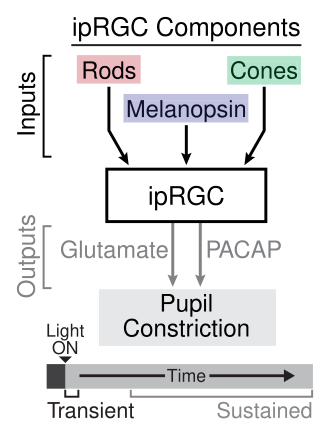Intrinsically photosensitive retinal ganglion cell
Specialized retinal cells involved in non-image-forming vision
Intrinsically photosensitive retinal ganglion cells (ipRGCs) are a type of retinal ganglion cell that are directly sensitive to light. They play a crucial role in non-image-forming visual functions, such as the regulation of circadian rhythms, the pupillary light reflex, and other physiological responses to ambient light levels.
Structure[edit]

ipRGCs are unique among retinal ganglion cells because they contain the photopigment melanopsin, which allows them to respond directly to light. These cells are located in the inner retina, and their dendrites extend into the inner plexiform layer.
Melanopsin[edit]

Melanopsin is a photopigment found in ipRGCs that is sensitive to blue light, with a peak sensitivity around 480 nm. This pigment is crucial for the light-sensing capabilities of ipRGCs, enabling them to perform their non-image-forming functions.
Function[edit]

ipRGCs are involved in several key physiological processes:
Circadian Rhythms[edit]
ipRGCs project to the suprachiasmatic nucleus (SCN) of the hypothalamus, which is the primary circadian pacemaker in mammals. By conveying information about ambient light levels, ipRGCs help synchronize the body's internal clock with the external environment.
Pupillary Light Reflex[edit]

The pupillary light reflex is another important function of ipRGCs. These cells send signals to the pretectal area of the brain, which in turn controls the constriction of the pupil in response to light.
Other Functions[edit]
ipRGCs also contribute to mood regulation and sleep patterns by influencing the release of melatonin and other hormones. They may also play a role in seasonal affective disorder and other light-related mood disorders.
Development[edit]
ipRGCs develop early in the retina and are among the first retinal cells to become functional. Their development is crucial for the establishment of circadian rhythms and other light-dependent physiological processes.
Clinical Significance[edit]
Dysfunction of ipRGCs can lead to various disorders, including circadian rhythm sleep disorders and abnormal pupillary responses. Research into ipRGCs is ongoing, with potential implications for treating these and other conditions.
Related pages[edit]
Ad. Transform your life with W8MD's Budget GLP-1 injections from $75


W8MD offers a medical weight loss program to lose weight in Philadelphia. Our physician-supervised medical weight loss provides:
- Weight loss injections in NYC (generic and brand names):
- Zepbound / Mounjaro, Wegovy / Ozempic, Saxenda
- Most insurances accepted or discounted self-pay rates. We will obtain insurance prior authorizations if needed.
- Generic GLP1 weight loss injections from $75 for the starting dose.
- Also offer prescription weight loss medications including Phentermine, Qsymia, Diethylpropion, Contrave etc.
NYC weight loss doctor appointmentsNYC weight loss doctor appointments
Start your NYC weight loss journey today at our NYC medical weight loss and Philadelphia medical weight loss clinics.
- Call 718-946-5500 to lose weight in NYC or for medical weight loss in Philadelphia 215-676-2334.
- Tags:NYC medical weight loss, Philadelphia lose weight Zepbound NYC, Budget GLP1 weight loss injections, Wegovy Philadelphia, Wegovy NYC, Philadelphia medical weight loss, Brookly weight loss and Wegovy NYC
|
WikiMD's Wellness Encyclopedia |
| Let Food Be Thy Medicine Medicine Thy Food - Hippocrates |
Medical Disclaimer: WikiMD is not a substitute for professional medical advice. The information on WikiMD is provided as an information resource only, may be incorrect, outdated or misleading, and is not to be used or relied on for any diagnostic or treatment purposes. Please consult your health care provider before making any healthcare decisions or for guidance about a specific medical condition. WikiMD expressly disclaims responsibility, and shall have no liability, for any damages, loss, injury, or liability whatsoever suffered as a result of your reliance on the information contained in this site. By visiting this site you agree to the foregoing terms and conditions, which may from time to time be changed or supplemented by WikiMD. If you do not agree to the foregoing terms and conditions, you should not enter or use this site. See full disclaimer.
Credits:Most images are courtesy of Wikimedia commons, and templates, categories Wikipedia, licensed under CC BY SA or similar.
Translate this page: - East Asian
中文,
日本,
한국어,
South Asian
हिन्दी,
தமிழ்,
తెలుగు,
Urdu,
ಕನ್ನಡ,
Southeast Asian
Indonesian,
Vietnamese,
Thai,
မြန်မာဘာသာ,
বাংলা
European
español,
Deutsch,
français,
Greek,
português do Brasil,
polski,
română,
русский,
Nederlands,
norsk,
svenska,
suomi,
Italian
Middle Eastern & African
عربى,
Turkish,
Persian,
Hebrew,
Afrikaans,
isiZulu,
Kiswahili,
Other
Bulgarian,
Hungarian,
Czech,
Swedish,
മലയാളം,
मराठी,
ਪੰਜਾਬੀ,
ગુજરાતી,
Portuguese,
Ukrainian